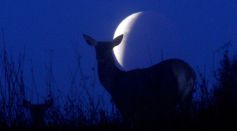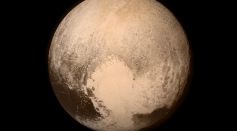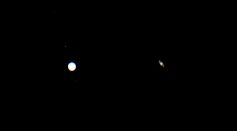Tags: Moon

China Yutu-2 Rover Resolves This Weird, Mysterious Cube on the Moon

Chang'e 5 Lander Finds Water On Moon; Did It Match Previous Discoveries?

Behaviors of Animals and Plants Strongly Influenced by Gravitational Tides from Sun and Moon, Experts Confirmed

January 2022 Sky Events: Here Are The Things Stargazers Should Look Up This Month

Did NASA Juno Spacecraft Just Hear Jupiter 's Moon? Here's What Happened!

NASA Mission: Apollo 17 Rock Sample Troctolite 76535 Shows Moon Is Cooler Than Everyone Thought

Pluto Demotion to Dwarf Planet Rooted in Folklore? Scientists Want to Reinstate It, Make Moons As New Planet

Night Sky Celestial Event in December: Watch the Moon as it Aligns with Planets Jupiter, Saturn, and Venus on Friday
Is the Moon Becoming the New Territory of Conflict? Military Efforts Ramping Up in Cislunar Space
Asteroids Slamming on the Moon Produce Light Like Fireworks! Here's How It Happens [LOOK]
'Full Cold Moon' Will Rise in December to Illuminate Canada's Longest, Darkest Nights of the Year

NASA Wants People to Help Them Put a Nuclear Power Plant on the Moon by 2030; Here’s How

Kamoʻoalewa Quasi-Satellite Might Be A Piece Of Moon, Researchers Say

Lunar Eclipse 2021: Amazing Pictures of Beaver Moon Delighted Stargazers [See Photos]

Thomas Pesquet Sets Longest European Spacewalk Record Outside ISS; Astronaut Wants To Explore Moon and Mars
Earth's Constant Companion Asteroid As Big as a Ferris Wheel Could Be A Fragment of the Moon, Study Suggests
Partial Lunar Eclipse Will Be High in North American Skies: Here's When and Where It Will Be Visible
NASA Says First Crewed Artemis Moon Landing Delayed Until 2025
Up in the Sky: Venus, Jupiter, Saturn Captured in Stunning Photos as They All Line Up with the Moon
Ice-Mining Experiment on the Moon’s South Pole May Help in Building a Lunar Base
Most Popular

Viruses vs Bacteria: Key Differences, How They Spread, and How We Treat Them

What Is Conservation Biology? Key Strategies to Protect Species and Habitats

Recycling Myths vs Facts: What Actually Gets Recycled and How to Do It Right

Digestive System Step by Step: From Ingestion to Absorption





